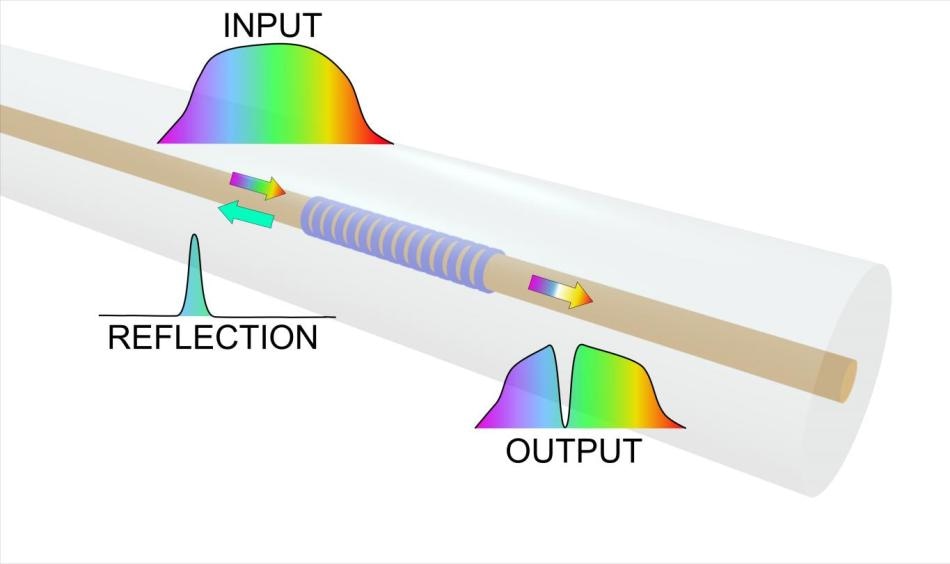Feb 6 2018
As a first ever attempt, scientists have developed sensing elements called fiber Bragg gratings within optical fibers, formed to dissolve absolutely within the body. The bioresorbable fiber Bragg gratings can be adopted for in-body observation of bone fracture healing and for secure investigation of sensitive organs, for example, the brain.
 Fiber Bragg gratings are used to turn an optical fiber into a sensing element by reflecting a specific wavelength back in the direction from which it came. New dissolvable fiber Bragg gratings can be used as sensors in the body and are safe even if the fiber were to accidently break inside the patient. CREDIT: Maria Konstantaki, Foundation of Research and Technology—Hellas.
Fiber Bragg gratings are used to turn an optical fiber into a sensing element by reflecting a specific wavelength back in the direction from which it came. New dissolvable fiber Bragg gratings can be used as sensors in the body and are safe even if the fiber were to accidently break inside the patient. CREDIT: Maria Konstantaki, Foundation of Research and Technology—Hellas.
Fiber Bragg gratings are optical elements fabricated within an optical fiber, largely used as a sensing instrument. Despite the fact that fiber Bragg gratings are widely used for applications such as monitoring the stability of airplane wings or real-time observation of the structural strength of bridges, to date, they have not displayed properties preferable for use inside the body. Developed with a design that enables them to get disintegrated similar to dissolvable stitches, the innovative glass fibers seem to be safe for patients even upon accidental breakage, noted the scientists.
“Our work paves the way toward optical fiber sensors that can be safely inserted into the human body,” stated Maria Konstantaki, a member of the research team from the Institute of Electronic Structure and Laser (IESL) of the Foundation of Research and Technology—Hellas (FORTH), Greece, that developed and described the innovative gratings. “Because they dissolve, these sensors don’t need to be removed after use and would enable new ways to perform efficient treatments and diagnoses in the body.”
The FORTH scientists worked in partnership with researchers from the Politecnico di Torino and Istituto Superiore Mario Boella, Italy, who designed, created, and described the distinctive optical fiber used for the study. The scientists have described the way gratings fabricated into the bioresorbable glass fiber dissolve under conditions simulating those inside the human body, in Optics Letters journal published by The Optical Society (OSA).
The innovative bioresorbable optical fiber Bragg gratings can be used to monitor pressure at joints or function as small probes with the ability to securely access and evaluate the heart and other intricate organs. Laser-based methods for eliminating tumors could also be enhanced by using these optical fiber gratings, which can concurrently deliver the laser beam and provide the precise real-time temperature sensing needed to observe the laser ablation procedure.
This is the first time that a widely used and well-calibrated optical element such as a Bragg grating has been etched into a bioresorbable optical fiber. Our approach could potentially be used to create various types of interconnected structures in or on bioresorbable optical fibers, allowing a wide range of sensing and biochemical analysis techniques to be performed inside the body.
Maria Konstantaki
Making glass that dissolves
In order to fabricate optical fiber Bragg gratings that can be securely used within the body, the scientists created a distinctive kind of glass formed of phosphorous oxide integrated with oxides of magnesium, calcium, silicon, and sodium.
This glass combines excellent optical properties with biocompatibility and water solubility, thus providing a reliable platform from which to make optical fibers that dissolve in water or biological fluids. The properties of the optical fibers can be tuned by properly changing the glass composition.
Daniel Milanese, Politecnico di Torino
Optical fiber Bragg gratings are etched by means of a laser to inscribe a pattern on an optical fiber, where the pattern makes the fiber to reflect a particular wavelength of light back in the direction from which it was delivered. A grating type called tilted optical fiber Bragg grating enables a specific portion of the reflected light to get away from the fiber core and penetrate into the enclosed cladding. Tilted gratings are usually adopted for sensing as alterations on the fiber cylindrical surface change the reflected light such that it can be monitored.
The researchers developed tilted as well as standard optical fiber Bragg gratings to gain in-depth knowledge of the way parameters adopted for inscription impacted the grating sensing properties. They discovered that when the bioresorbable fiber was exposed to ultraviolet laser light with a specified spatial intensity distribution, describing the way laser beam power is distributed, a corresponding surface relief pattern was formed in the optical fiber volume subsequent to dissolution.
This finding paves the way for new applications of these types of materials, particularly in the fiber form. Complex fluidic or optical structures could be created using lasers to make a device with a host of tailored functionalities.
Stavros Pissadakis, Head of the FORTH group
Once the researchers asserted that the patterns developed during the inscription procedure functioned as a fiber Bragg grating, they immersed fibers with and without fiber Bragg gratings into a solution with temperature conditions and pH similar to that of the human body for 56 hours. They discovered that the glass etched with laser light dissolved quicker when compared to the unexposed glass.
At present, the researchers are carrying out systematic experiments to gain better knowledge of the way the ultraviolet laser irradiation conditions and fiber composition impact the speed at which the fiber Bragg grating gets dissolved. This information can be used to develop fiber Bragg gratings with the ability to get dissolved within a particular time period. Prior to being used in humans, the sensing and dissolving characteristics of the fiber Bragg gratings will have to be investigated in animals.